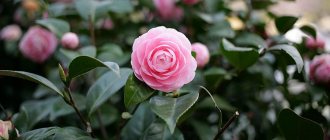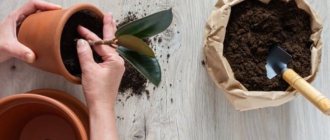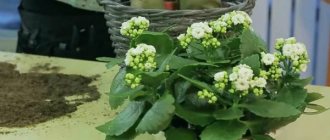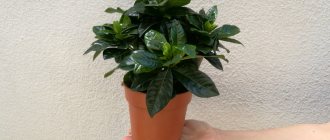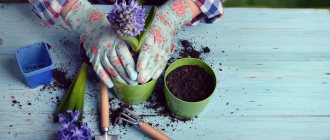Home House and cottage Garden and vegetable garden
Indoor flowers are always a joy to the eye and soul. A small oasis in the apartment can calm the nerves and clean the air in the room at any time, since everyone knows that house plants have beneficial qualities and properties. This is why every housewife loves to grow crops so much. Moreover, many types of flowers are easy to care for, and their health does not depend on the humidity and climate in the room.
All thoughts and understanding about planting and agriculture have long been associated with the calendar schedule. And not in vain, because, naturally, at a time when the earth is covered with caps of snow, it sleeps. Therefore, it is customary to start both gardening and home floriculture in the spring.
In order for an indoor flower to be green and beautiful at any time, regardless of the season, you need to provide it with regular, high-quality care. Timely replanting is the key to favorable development and growth of the root system and, naturally, the plant itself. Treatment with fertilizers and proper watering also require uniformity and regularity, and if these conditions are not met, the green window resident may die. To properly transport a flower or its cuttings to another pot, you need to know the time when it is appropriate and worth doing.
The degree of need to replant a plant can be determined not only by the growth of its foliage, but also by its appearance and root system.
To check whether it’s time for a green pet to move into another, larger container, water it and carefully, being careful not to damage the root, remove it from the pot. If the root system has grown abundantly and densely, entwining the soil around itself, the green light is on for replanting.
How else can you understand that a houseplant needs to change its “place of residence”?
You can determine that a flower has become cramped and ill in an old pot by the following identification signs:
- Settled soil and protrusion of the overgrown root system to the surface.
- The plant began to grow poorly and produce cuttings.
- Yellow foliage color. With this sign, it is necessary to exclude the presence of disease in the plant, lack of moisture flow, and the appearance of pests.
- During flowering, the plant's buds became noticeably smaller than before.
- The flower stopped growing altogether.
- The flower is cramped in the pot.
- Earth oxide has occurred - this sign can be identified by a whitish coating on the inner walls of the pot, as well as by the unpleasant odor emanating from the soil.
- The previous plant transplant was carried out a long time ago.
- The leaves began to turn yellow and fall off.
- Just bought a flower. Since stores sell plants in pots with soil that is unsuitable for growing, it is worth replacing it.
- Depletion of the land. In this case, the flower will begin to wither and dry out, since it does not receive the required amount of microelements necessary for the growth and development of the root system and the bush itself.
Favorable periods for moving a plant to another location
Transplantation, as a process that is not entirely natural in nature, is painful for a houseplant, and proper care for it in the first days after the procedure is an essential condition for subsequent growth. Both gardening and home gardening require adherence to rules and time that are considered the best for flower adaptation:
- You need to navigate by the time of day. The transplant procedure should begin no earlier than four o'clock in the afternoon and no more than eight in the evening.
- The lunar calendar is the boss of everything. The most favorable days for crop production can be found here. Usually, this is the time when the moon begins to rise. It is generally accepted that during such a period it is necessary to start not only new things, but also to perform gardening maneuvers.
- The earth's satellite is located in such signs as Cancer, Taurus, Libra, Pisces, Scorpio, Capricorn. You can always find these days in the lunar calendar. Usually the 1st, 28th and 29th are the most favorable numbers.
For the fastest and least painful adaptation of the flower roots to the new soil and place, you need to choose a time when the plant has not yet begun to grow. Flower growers consider the end of February-April to be the most optimal.
If the flower begins to produce buds, then it cannot be replanted during this period. Wait until the flowering stage is over.
Houseplants with decorative foliage, as well as woody and herbaceous plants, are replanted once a year, and if the flower is large, it can last for about 5 years without this procedure. When transplanted frequently, such species can become sick and disappear. There is an important nuance when working with single-stemmed and sparsely branched plants: they should never be pruned, as they tolerate this procedure very poorly. Let these flowers grow properly, and only if cuttings appear, replant. Green households with unbranched root types also do not like pruning and similar types of interventions.
Several reasons to think about the advisability of replanting a plant:
- There are times when a flower begins to weaken, the foliage turns yellow, and the roots rot, but replanting is not a solution to the problem.
Symptoms: falling, yellowing of the foliage.
Treatment: proper watering, feeding, changing the location, normalizing the temperature and humidity in the room, eliminating the appearance of drafts.
- Inappropriate watering (either too abundant or scanty).
Symptoms: lethargy, yellowing of foliage, appearance of dry areas on the bush.
Treatment: watering the flower is carried out in the spring-summer period - twice every 10 days, in the autumn-winter period - 3-4 times every 30 days.
- Pathogenic microorganisms.
Symptoms: the appearance of small pests similar to aphids on the foliage and root bases.
Treatment: washing the green part of the plant with liquid and grated laundry soap. We maintain the following proportions: 1 teaspoon of soap per 1 liter of clean water.
- The color is falling.
Symptoms: the plant drops buds that have not yet bloomed.
Reason: dry air during the heating season or too frequent and strong watering.
Treatment: humidify the air or spray the plant daily with water from a spray bottle. You only need to water the flower after making sure that the soil in the pot is completely dry.
Lunar calendar for 2022: favorable days
To shorten the adaptation period after transplantation and achieve gorgeous flowering, you can take into account the instructions of the lunar calendar. This satellite of the Earth is capable of influencing all life on the planet, even the emotional and physical state of a person depends on the Moon. Care for indoor plants planned in accordance with the lunar calendar can ensure their well-being and give their owners delight and pleasure.
Also read: How to properly transplant hyacinth: step-by-step instructions with photos
Transplantation carried out according to lunar instructions will have a positive effect on the flowering period.
It is important to use only the current calendar for the current year, and not last year’s. Since those days that were successful last year may be prohibited this year.
For winter: December, January, February
Unfavorable days of the year
Research by scientists confirms the influence of the Moon on the movement of water, periodic vertical fluctuations in ocean levels, and the movement of plant juices from the root system to the foliage. Therefore, care must be coordinated with the lunar calendar, replanting only on favorable dates.
NOT favorable days in 2022:
Also, when planning an event, the florist needs to focus on the stage of development of the crop, which is why the period of the operation may not coincide with pre-planned actions based on the phases of the Moon and the general influence of the night star.
In addition to good and bad dates for transfer work, there are days that are considered neutral. These days it is allowed to carry out operations with ornamental plants, but the result will be average. This will not harm the shoots, but it will not help them fully survive the manipulation.
Choosing the best container as a new home for a houseplant
This issue must be approached as seriously as the transplant itself, because its condition, ability to breathe, and bloom on time depend on the pot in which the flower grows. This condition is necessary for proper distribution of liquid. So, if a houseplant with large leaves on a bush is transplanted into a voluminous and spacious pot, then all the liquid with useful microelements will concentrate in the soil. With a small pot, the picture is much more favorable - moisture and fertilizers, due to lack of space, will go into the trunk and foliage of the flower, thus ensuring its prosperity and intensive growth.
Before you start replanting a flower, you need to acquire unused, new pots. If this is not possible, thoroughly wash, sterilize and dry the old ones. This way you can get rid of all pathogenic microbes, rot, traces of oxidation and mold. Wooden containers are treated with concentrated soap solutions and sterilized with steam or boiling water.
Thanks to the development and demand for floristic services, in specialized stores you can purchase everything you need to transplant a green window resident. A mass of designerly designed pots, bowls, tubs, buckets, as well as a sea of fertilizers and all kinds of ready-made soil, allow the modern housewife to take care of indoor plants with pleasure. After purchasing the container you need for the flower, when you get home, let it sit in a bowl of water for about 25 minutes. This move is mandatory and prevents the walls of the pot from clogging with dust or pieces of earth. And this is very important, since such a nuisance will interfere with the normal movement of oxygen into the soil. As has already been said, you should not buy too spacious dishes for plants with an extensive root system. A container for ornamental trees or palms should be made primarily of hardwood. These can be beech, oak and birch. In each of the pots, before transplanting, you need to drill holes at the bottom for air intake.
Re-inspection of the flower at home
Before deciding what to do with purchased flowers immediately after purchase, you need to carefully examine them again. First, the degree of plant injury that occurred during delivery is assessed. Inspect the entire above-ground part (trunk, shoots, leaves, buds, etc.) for mechanical damage. Broken elements of the flower are removed so that the new tenant does not waste energy restoring them. Fresh sections are sprinkled with finely ground charcoal (charcoal or activated), cauterized with ordinary brilliant green or treated with specialized means (balms, solutions, etc.).
Then, armed with a magnifying glass, they carefully examine the green pet again after purchase for the presence of insects and signs of disease. At the slightest suspicion, the bush is sprayed with a soap solution (preferably green) or potassium permanganate (light pink) for prevention several times at intervals of 3-5 days. Identified pests or specific symptoms of any dangerous disease will serve as a reason for emergency treatment of the flower with appropriate drugs.
What soil can be used when replanting plants?
A prerequisite for the correct transplantation of any plant is the soil in which the root will be planted.
- Soil with an average composition includes: two portions of peat and leaf soil, one part of humus and 1.5 portions of river sand.
- Soil with a heavy composition: turf soil three portions, two parts each of leaf soil and humus, 1.5 parts of river sand. Soil with a light composition: 3 portions of peat, 1 portion of leaf soil and 1.5 parts sand.
In the absence or impossibility of buying one or another type of soil, for example, peat or deciduous soil, you can replace them with other components - humus or sand.
When mixing the future base for the root system of the flower, one portion of crushed charcoal should be added to each composition. If you don’t know where to buy the components that make up the “correct” soil, take regular soil from your garden or suburban area. The soil there is definitely fortified and saturated with useful compounds.
When preparing the soil for each plant, you need to know whether it is suitable for the flower to develop well. So, for green owners of thick and fleshy roots, you should choose a heavy soil composition. Here the main component will be turf soil, rotted for one year. Flowers with a thin and fragile root system prefer light soil.
Selection of pot
The pot is selected according to size and volume. The material from which the container is made is taken into account. Its size is chosen wider and deeper by 4-5 centimeters. To calculate the volume of the required pot, you can add 10% to the previous one when replanting.
Plastic pots are lightweight, and small plants can be replanted in them, as well as young pagons and shoots for propagation. Tall plants should be replanted in clay or ceramic containers that are heavy and stable. Clay and ceramic pots need to be washed well, doused with boiling water, and soaked overnight.
How to replant a flower?
Many housewives use two methods of this procedure: moving the flower to another pot and partially replacing the soil. Moreover, the latter option is more favorable and acceptable, since it does not imply disturbance to the root system. It takes place when you see that the soil in the pot is still fertile and fresh in appearance, and the flower growing from it is not subject to pathogenic processes.
- So, we start replanting from the ground by purchasing a suitable substrate for each flower or by mixing soil components as described above.
- If the soil is prepared with your own hands, it must be sterilized from possible pests. To do this, steam the soil in a water bath for one to two hours. The container with soil must be hermetically sealed.
- After the measured time has passed, heat the sterilized soil in the oven at a temperature of 40 degrees. The procedure will take no more than thirty minutes.
- After disinfection work, the soil should be allowed to cool and fertilizers and flower bait should be mixed into it.
- You can add pebbles or crushed stone to the bottom of the pot.
- The next layer is steamed soil. Add only as much mixture as the plant’s root system will allow. Please note that the flower should sit no deeper in the new container than in the old one.
- Before transplanting, lightly water the flower for further easy removal and let the moisture absorb for 20 minutes.
- After about half an hour, carefully remove the plant by lightly pulling the trunk, if it allows it. In another case, handy objects such as a spoon, fork or pencil will help you get the flower.
- After making sure that the root system of the green beauty is in order, carefully plant it in a new pot with half the soil content and sprinkle the second part on top, adding soil a little at a time if necessary.
- Using tapping movements, “pound” the loose soil to firmly anchor the plant to its new “home.”
- Lightly irrigate the transplanted flower with settled water.
While the flower is getting used to the new pot, place it in a warm room with a humid microclimate and water it half as often as usual.
Replanting an orchid
Truly, a delicate, feminine and beautiful indoor flower, the orchid, requires special attention and careful care, because during flowering its buds, which bloom in white, pink, red and lilac, must be “juicy,” healthy and large.
This plant loves cramped containers, so do not try to transplant the flower into a large bowl or deep pot. Before transplanting, an orchid will always let its owner know that it is time to change its “place of residence.” This can be understood by the following signs:
- The orchid has not been replanted for about three years and, since the soil releases useful microelements for two years, the next year it will be pretty depleted.
- The ground is clearly compacted and settled.
- The smell of hydrogen sulfide from the pot is a sign of rotting, maybe even of the root system.
- Plant ailments as a result of a high concentration of pests in the substrate. If the flower gradually fades away, withers and does not produce buds, perhaps this is the reason.
Features of transplantation of “Spathiphyllum” or “Women’s Happiness”
This flower, beloved by all the beautiful half of humanity, belongs to the aroid family and has its roots in the distant American tropics. The plant blooms with white leaves, from the bases of which seed pods grow. It can reach an average of 30 cm in height. There are taller subspecies.
Spathiphyllum is not fussy and requires infrequent watering, about 2 times every 12 days.
After purchasing a flower in a store and bringing it home, be sure to prepare another substrate. The medium of the new soil should have a slightly acidic composition, and the soil itself should have a loose and airy structure. This condition will be provided by the following components: leaf and peat soil, humus, river sand and sawdust.
After preparing the substrate, it must be disinfected. For this, a solution of potassium permanganate is used. This approach to care will help protect the plant from pests.
Stages of transplantation of “Women’s Happiness”:
- Remove the flower from the purchased pot and carefully clean the roots from the old soil with your hands. This must be done without using water. Check to see if the root of the plant has any rotten areas. If there is a problem, trim it with scissors.
- We take a pre-sterilized small pot, because if the container is too bulky, “female happiness” may not bloom.
- 5-6 pieces of pebbles or expanded clay are placed at the bottom of the container.
- The drainage layer is covered with part of the soil.
- The third step is to carefully insert the flower with the roots down so that the soil covers them. Sprinkle another layer of substrate on top.
- Moisten the transplanted plant and spray the foliage with a spray bottle.
Before buying such a plant in a store, pay attention to whether it has flower ovaries. If such a situation is observed, it means that “female happiness” is no longer fresh and an attempt to bloom is rather an attempt to survive.
Spathiphyllum, as a houseplant, does not accept that it and its root system are touched during flowering, since during this period all the vitamins are absorbed by fresh buds and soon bloom. If, without knowing it, you did undergo a transplant, you may notice negative consequences based on the following signs:
- The tips of the leaves dry out.
- The plant becomes covered with dark spots.
- The lower leaves curl up.
If the root system of the plant has rotted or become a haven for parasites, then, of course, replanting cannot be avoided. The transshipment procedure will help here. The main condition of this method is to leave the soil on the root branch without removing it or washing it off with water. The soil must not be removed!
There are situations when “female happiness” began to hurt and bloom at the same time, and all efforts to cure the green pet were in vain, then replacing the substrate is mandatory.
When replanting a withering plant, carefully cut off the stems with flowers, leaving sprouts of 2 cm. Move the spathiphyllum into a new, treated pot.
Purchasing and transportation is the first step
The right approach to purchasing, rational and even prudent, is the best guarantee of success. Of course, indoor plants are first and foremost chosen with the heart. But in fact, the choice should be, first of all, practical. Beauty and irresistibility are good only when we can provide the plant with the conditions and care it needs.
You need to accurately assess where it will be located, whether it is consistent in style and size, whether it will fit into the collection, whether it will have enough light and whether the temperatures are suitable. From global factors like color scheme and influence on the perception of space to “little things” like the shape of leaves and type of structure - it is important to take everything into account.
Despite the fact that delivering a plant to your home is considered more of a part of the purchasing process, this is where crop adaptation begins. The degree of harm caused to the plant will depend on whether you remember the packaging rules, whether you treat the plant with care and whether you take into account all the factors. And he will definitely be there. Even a door-to-door car ride is still stressful for the plant. And the gardener’s task is to reduce it to a minimum. Caution, proper organization and lack of haste are the best helpers.
Mistakes made by many housewives after replanting indoor plants
Many housewives, having replanted indoor plants in the spring, believe that in the future, apart from watering, the flowers will not “ask for anything”. It's a delusion. Below are a few examples of such situations, or, more precisely, oversights:
- After the store, the new flower is placed on the window with other plants.
- A newly purchased flower is not replanted, but is left to grow in old, unsuitable soil.
- Illiterate choice of substance.
- Flowers are provided with early feeding.
The first point is justified by the fact that the still unknown soil of the green “newbie” may be inhabited by pests that will gladly move on to other victims. Then you will have to replant and treat all the flowers, even at the wrong time for this.
The second and third errors are also explainable. The fact is that the soil with which the manufacturer fills the flower pot for sale is not suitable for home use. So, in order not to make a mistake and not to destroy the plant, after the store you need to immediately replant it, having first selected a favorable substance. Also, some florists keep their flowers in peat, which within the household will have a detrimental effect on the growth and development of the green household.
Let's justify the third mistake. Since replanting an indoor flower is always stressful for it, many housewives, trying to alleviate the suffering of their green pet, begin to stuff it with all kinds of fertilizers and bait. This cannot be done until the flower has completely adapted to the new soil. So the plant should be fertilized 30 days after transplantation.
Selecting a container for transplantation
The size of the new pot should be 20% larger than the old one, and its height should be at least 1/3 of the height of the plant itself. The parameters of a pot are considered ideal when its diameter is equal to 2/3 of the height of the flower. For replanting indoor plants, plastic or clay (ceramic) containers are often chosen. Their advantages and disadvantages:
| Type of pot | Advantages | Flaws |
| Ceramic | The material has good air permeability Durability Resistance to damage | High price Significant weight |
| Plastic | Low price Retains moisture for a long time Light weight | Due to poor air permeability, a steam bath is created inside, and the root system may rot |
Care after transplant
After transplantation, spathiphyllum accepts a favorable and humid microclimate. To ensure this, you need to lightly wrap it in a plastic or cellophane bag. It is very important to remember to irrigate the plant on time, since this period is stressful for it and requires special care. There is no need to change the mode and intensity of watering to a lesser or greater extent: everything should be as before. The spathiphyllum needs to stay under the cellophane covering for about 2 weeks. This “hood” is periodically removed when the room is ventilated, once every three days.
If you notice the blackening of “female happiness” after the transplant, pay attention to the temperature of the room - perhaps it is too low. Another reason for such changes may be the intensity and frequency of irrigation. In this case, reduce and then increase the amount of liquid consumed by the flower. The way the flower reacts will answer all questions.
Fertilizer for ovary color
An important condition for the favorable development of a flower after transplantation is the absence of fertilizing and fertilizers in its diet for 60 days.
After this period, the following fertilizers are welcome:
- For good and high-quality growth of foliage and the formation of buds, mineral bait is suitable. After you have achieved the result and the flower has bloomed, the healing procedures will have to be suspended for a while.
- It is not uncommon for “female happiness” to have light green buds instead of white. This may be the reason for the lack of potassium and phosphorus in the plant, and you need to purchase appropriate fertilizers.
To avoid damaging the root system, the soil in the pot should be watered with settled water before fertilizing. Make sure that the remains of the bait do not settle on the foliage of the plant, otherwise this could lead to the appearance of external defects.
